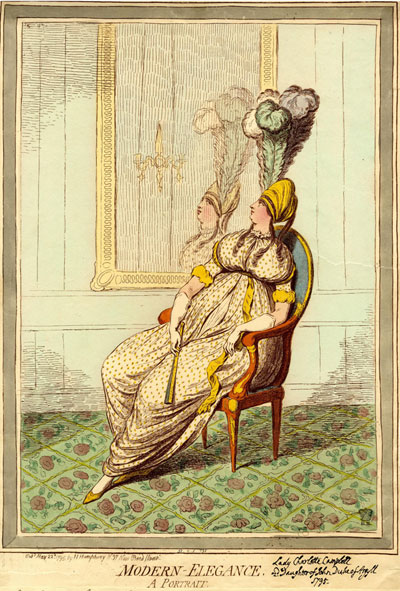Modern Elegance. A Portrait
This ironically titled print lies at the intersection of at least three genres: a portrait caricature, a satire of women's vanity and dress, and a parody of fashionable modern portraiture.

© Trustees of the British Museum
Like most portrait caricatures, "Modern Elegance" shows the subject at full length with her face in profile seen against a minimal background. And again like traditional portrait caricatures, the title hints at but does not reveal her identity, except to those sophisticated persons "in the know." The hint seems to have been sufficient. Among copies of the print in major museums and collections, the print is often and consistently annotated (as the one in the British Museum) with the name of Lady Charlotte Campbell (1775 - 1861).
In 1795 Charlotte Campbell was one of the most eligible and attractive young women in the country. The daughter of the 5th Duke of Argyll and the beautiful and oft-portrayed Elizabeth Gunning, Duchess of Hamilton and Argyll, Charlotte traveled in the most exclusive of circles. The Edinburgh Advertiser for January 21, for instance, lists her among privileged attendees at the Queen's Birthdary celebration in 1794 dancing a minuet with the Earl of Morton immediately following the Princes of Wales, Clarence, and Gloucester. The same newspaper records a rout hosted by her mother and attended by the Prince of Wales and the new Turkish Ambassador.
She seems to have had an active interest in the arts. In July of 1794 we find a Mr. J. Parsons dedicating his book, The Elements of Music to her . Closer to Gillray, the Morning Post and Fashionable World for April 24, 1795 reports her attendance at the " the Exhibition of Earl Howe's Victory painted hy Loutherbourg" to which Gillray had contributed sketches. And in 1797, she published a book of her own poems, Poems on Several Occasions by a Lady.
Gillray's portrayal of Charlotte Campbell is, however, hardly flattering. Her figure which, as the British Museum commentary notes, was a subject of much appreciation, seems to have ballooned out of proportion. And, of course, she is shown with all the accoutrements of the latest 1795 fashions—the turban-like headress, the absurdly high feathers (four of them!) and the obligatory fan. Finally, Gillray shows her stealing a look at her own image in the mirror thus suggesting the age old theme of women's vanity.
Serious portraiture at the time, was becoming less formal. No longer did sitters have to stand or sit stiffly erect. Both sexes were now shown more relaxed, doing something, walking alone or together, or engaged in some activity. Gillray takes this tendency to its extreme, showing a too relaxed Lady Campbell, self-absorbed, indifferent to how she appears in this "portrait"‐ a convention-breaking, diagonal figure amid otherwise vertical and horizontal lines.
Sources and Reading
- Commentary from the British Museum on Modern Elegance.
- "Lady Charlotte Bury," Wikipedia
- "Elizabeth Hamilton, 1st Baroness Hamilton of Hameldon," Wikipedia
- Thomas Wright and R.H. Evans, Historical and Descriptive Account of the Caricatures of James Gillray #400.
- Thomas Wright and Joseph Grego, The Works of James Gillray, the Caricaturist; With the History of His Life and Times, p. 196.
Comments & Corrections
NOTE: Comments and/or corrections are always appreciated. To make that easier, I have included a form below that you can use. I promise never to share any of the info provided without your express permission.